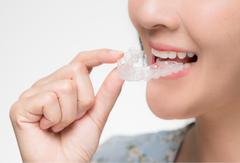How Diet and Beverages Affect Your Retainer's Cleanliness
The food and drinks you consume daily can significantly impact the cleanliness and lifespan of your retainer. While retainers are designed to help maintain your new smile, they can also trap residue from meals and beverages if not cared for properly. Over time, this buildup can lead to staining, odor, and bacterial growth.
Dark-colored drinks like coffee, tea, and red wine are common culprits that can discolor clear retainers. Acidic and sugary beverages such as soda or citrus juices may weaken the material, making the retainer more susceptible to wear. Sticky or hard foods can also cling to the retainer or damage its structure if it’s not removed before eating.
Maintaining proper hygiene is essential. Smileie encourages users to remove their retainers during meals and rinse both mouth and appliance before reinserting. For additional maintenance tips, Smileie’s article on maintaining oral hygiene with clear aligners provides practical guidance.
By being mindful of your diet and following a consistent care routine, you can keep your retainer fresh, clear, and functional for the long term—protecting your smile investment and supporting daily oral health.
Understanding the Impact of Diet on Retainer Hygiene
Your diet plays a direct role in the cleanliness and longevity of your retainer. Because retainers sit closely against your teeth, they are exposed to every substance that enters your mouth. This includes food particles, colorants, sugars, and acids that can cling to the surface and promote discoloration, odor, or even bacterial growth.
Colored beverages such as tea, coffee, and soft drinks can stain clear retainers, making them appear dull and unclean. Meanwhile, foods high in sugar or acid create an ideal environment for bacteria, which may lead to plaque buildup on the retainer if not cleaned properly. Even healthy choices like berries or tomato-based sauces can leave pigments behind that are difficult to remove.
To preserve the clarity and hygiene of your retainer, it’s important to understand how your eating habits affect it. Smileie emphasizes that combining smart dietary choices with a consistent retainer cleaning routine is key to maintaining both your appliance and your oral health.
Foods and Beverages That Stain or Damage Retainers
Certain foods and drinks are known to stain or damage retainers, especially clear plastic models. Pigmented beverages such as coffee, tea, red wine, and dark sodas contain chromogens and tannins that cling to retainer surfaces. When consumed regularly without proper cleaning, these substances can leave behind yellow or brown discoloration that is difficult to reverse.
Acidic foods and drinks, including citrus fruits, vinegar-based sauces, and carbonated beverages, can erode the surface of the retainer. This not only affects its transparency but also weakens the material over time. Sticky or chewy snacks like caramel and gum can adhere to the appliance and are difficult to remove, increasing the risk of bacterial buildup.
Smileie recommends removing your retainer before consuming anything other than water to protect its clarity and structural integrity. For detailed cleaning tips and best practices, Smileie’s clear aligner care guide offers helpful insight into daily maintenance and preventive measures that also apply to retainers.
Best Practices for Eating and Drinking with Retainers
Maintaining your retainer’s cleanliness begins with mindful habits around eating and drinking. The best practice is to always remove your retainer before meals or sipping anything other than water. Eating with the retainer in place can lead to trapped food particles, staining, and even damage if the appliance is exposed to hard or sticky textures.
After meals, rinse your mouth and clean your retainer with a soft brush and non-abrasive cleanser before reinserting it. This helps eliminate residue and prevents bacteria from lingering on the surface. If you're away from home, rinsing with water and using a retainer case for temporary storage is recommended.
According to Smiles of Boca, beverages like coffee, tea, and soda can leave lasting stains and should be avoided while wearing retainers. Adopting these simple yet effective practices ensures your retainer remains clear, odor-free, and continues to support your smile effectively.
Smileie's Recommendations for Retainer Care
At Smileie, maintaining the cleanliness and longevity of your retainer is an essential part of preserving your smile. Retainers should always be removed before eating or drinking anything other than water to avoid staining, residue buildup, and potential distortion of the appliance. After each meal or beverage, rinse your retainer and your mouth to minimize the risk of bacteria settling on the surface.
Smileie advises cleaning your retainer daily using a soft-bristled brush and a non-alcoholic, non-abrasive cleanser to maintain its clarity and structure. Avoid hot water or harsh chemicals, which can warp or damage the plastic. Retainers should always be stored in a ventilated case when not in use, protecting them from contamination and physical damage.
For more oral hygiene guidance while using orthodontic appliances, Smileie’s blog on maintaining oral hygiene with clear aligners offers useful care strategies that also apply to retainers. Consistent, gentle care will keep your retainer fresh, clear, and working effectively.

Latest Blog
-

-

-
 Oct 10, 2025
Oct 10, 2025Clear Aligners and Confidence: How They Transform Smiles Without Metal Wires
Learn More -
 Oct 09, 2025
Oct 09, 2025Clear Aligners vs. Ceramic Braces: Which Is Better for Adults and Professionals?
Learn More

 USA
USA Canada
Canada UK
UK Italy
Italy Sweden
Sweden Australia
Australia




